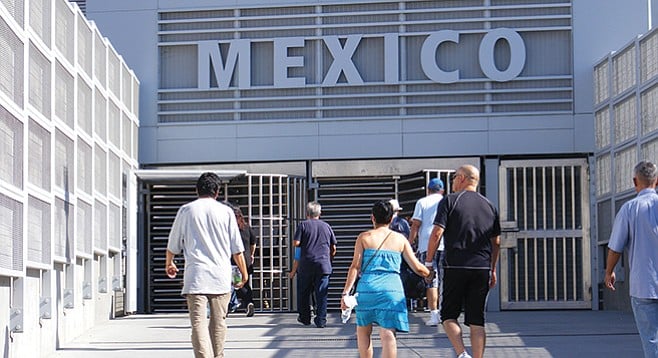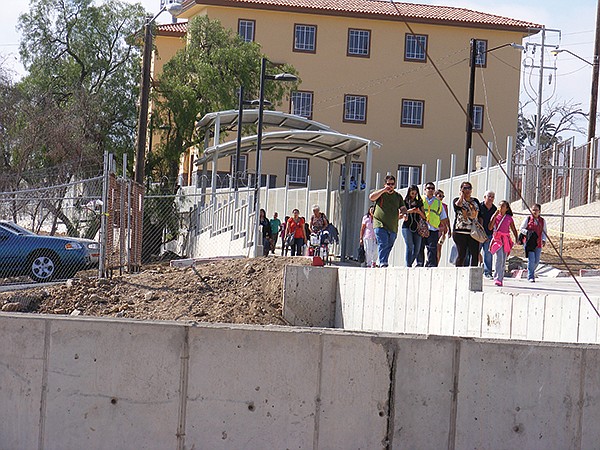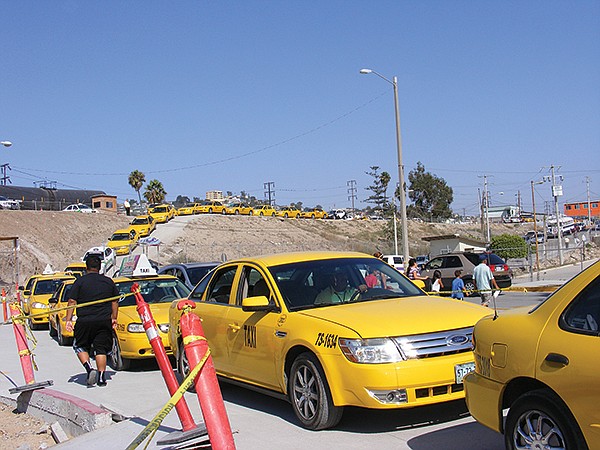 Facebook
Facebook
 X
X
 Instagram
Instagram
 TikTok
TikTok
 Youtube
Youtube

Crossing into Tijuana has changed for many San Diego residents who enjoy the opportunity to shop, party, and otherwise explore the most visited city in the world. The looming question is how the change will affect business in Tijuana and the tourists and ex-pats who keep such businesses afloat.
For decades, visitors crossed into Tijuana at the San Ysidro Port of Entry on foot and were only hassled concerning any items they might be bringing into Mexico. If your cargo was larger than a backpack, you could have been asked to push a button on a machine resembling a stop sign — red meant you were searched and green meant you were free to go. As their U.S. counterparts began to tighten foot traffic into the U.S. in the mid-1990s, Mexico’s criteria remained loose and even whimsical pertaining to entry into Baja.

When Mexico opened a new San Ysidro pedestrian entry in mid-August, the routine changed drastically. In fact, the only truly whimsical part of entering Tijuana through San Ysidro on foot that remains consistent is the red light/green light procedure when it comes to checking your baggage — only now they employ the use of a modern x-ray machine and conveyor belt.
The federal government of Mexico is in the process of gaining the capacity to handle the northern Baja border in the manner they see fit, with the cooperation and help from the state government. The facility on the San Ysidro pedestrian border crossing, at a cost of almost $7 million, is only the first upgrade planned for international crossings into Mexico along the Baja California border with the U.S.
“We’re currently working on Otay,” said Rodulfo Figueroa Pacheco, the federal delegate in charge of the international border in Baja California. “We expect that facility to be opened between one and two years from now.”
Figueroa and Mexico’s national migration agency now have offices in Tijuana, just off of the inland route to Rosarito Beach. He and his team are responsible for the six land entries in their various forms, along with four airports and six seaports in Baja California. The plan is that eventually all ports of entry will comply with what has been Mexican law for many decades.
“The notion of a zona frontera [border zone] was never a law,” Figueroa said. “All people who are not Mexican citizens must have travel documents, like in any other country. Mexican citizens must show proof of their citizenship.”
Mexico considers travel documents as a passport or a passport card, and Mexican citizens can use their voter-registration card or even a copy of their birth certificate. Many visiting Tijuana and other northern border cities were once told that they were permitted to remain within 25 miles of the border — the zona frontera — sans a visa or a passport, but according to Figueroa that was never federal law.
Figueroa was adamant about his role concerning the new border policies. “We haven’t invented any new laws here, we’re not legislators. We’re here to enforce laws that have been in existence for many decades,” he said.
Jeff Anderson lived in Tijuana and worked in the U.S. for over a decade before moving back across to the South Bay a couple of years ago. He maintains friendships in Tijuana and crosses to visit, but the new rules have changed the way he has to cross.
“I can’t get a passport now due to back child-support, even though I’m paying it off; my paycheck gets hit every week. So, when I cross, I either pitch a couple of dollars at someone driving in or I go to Otay and cross there,” he said.
Currently, only pedestrians are required to show travel documents or proof of Mexican citizenship when entering Tijuana from San Ysidro, including those arriving by bus or other shuttle services. Drivers and passengers of private vehicles are not affected.
“We don’t currently have the resources to enforce travel documents for drivers and passengers of automobiles coming into Baja from San Ysidro,” Figueroa admitted. “As technology advances, perhaps we will find a way.”
Local businesses in Tijuana have been affected by the new pedestrian crossing, some more so than others. The majority of managers and employees of the restaurants and curio shops on Avenida Revolución, along with several hotels in the area, report a slight downturn over the Labor Day holiday, but nothing drastic.
“We were sold out the Saturday of the Labor Day weekend by 8 p.m., which is normal for any Saturday here,” said the front desk clerk at Hotel Leyva. “But we failed to sell all of our rooms on the Saturdays directly after the change at the border, which has never happened.”
On Avenida Revolución, most businesses remained upbeat. The cantinas and restaurants were busy enough, although the curio shops seemed to be struggling. “This won’t last,” said one owner lacking business. “They’ll get enough pressure to relax the requirements to enter Tijuana.”
This may be true, and it’s certainly the consensus of tijuanenses who depend on tourism in order to make a living. Even Figueroa conceded, “We’re going through a learning curve here; we’ll make adjustments as warranted.”

One portion of Tijuana that adjustments likely will not help is the plaza and corridor that leads to downtown Tijuana from the border on foot. The new exit into Tijuana is farther north and folks passing through are instantly introduced to a long line of taxis. Cab drivers ushering people into cabs casually block the sidewalk leading toward the pedestrian walkway to downtown.
“There is no more business,” said the doorman to Margarita’s Bar and Grill, located near the pedestrian bridge over the Tijuana River. “We’ll have to close and open somewhere else.”
The City of Tijuana remodeled the plaza leading to that bridge less than two decades ago. But after the U.S. became stricter with requirements for returning tourists, the dread of long return lines cost those potential businesses dearly. The new southbound requirements have reduced business further, and the plaza looks like a ghost town.
Despite the negative effects the new border may have on Tijuana tourism, Figueroa points out that the changes are in the best interests of everyone. “When hurricane Odile wiped out Cabo and struck La Paz, we discovered that three times the number of Americans lived there than we had documented. How are we supposed to notify their countries of origin if we have no idea who they are?” he said.
Meanwhile, tourists and visitors take the new requirements in stride.
“I know if I don’t stay more than a week I don’t have to pay for the six-month tourist visa, but I did it anyway,” said one frequent visitor. “I’m only here two weekends every month or so, but if paying the $20 fee means I don’t have to fill out paperwork every time I cross, then it’s worth it.”
Businesses in Tijuana can only hope that many Americans agree. According to Figueroa, between 22,000 and 30,000 pedestrians cross into Tijuana from San Ysidro on any given day...and Mexico aims to ensure they are documented.


Crossing into Tijuana has changed for many San Diego residents who enjoy the opportunity to shop, party, and otherwise explore the most visited city in the world. The looming question is how the change will affect business in Tijuana and the tourists and ex-pats who keep such businesses afloat.
For decades, visitors crossed into Tijuana at the San Ysidro Port of Entry on foot and were only hassled concerning any items they might be bringing into Mexico. If your cargo was larger than a backpack, you could have been asked to push a button on a machine resembling a stop sign — red meant you were searched and green meant you were free to go. As their U.S. counterparts began to tighten foot traffic into the U.S. in the mid-1990s, Mexico’s criteria remained loose and even whimsical pertaining to entry into Baja.

When Mexico opened a new San Ysidro pedestrian entry in mid-August, the routine changed drastically. In fact, the only truly whimsical part of entering Tijuana through San Ysidro on foot that remains consistent is the red light/green light procedure when it comes to checking your baggage — only now they employ the use of a modern x-ray machine and conveyor belt.
The federal government of Mexico is in the process of gaining the capacity to handle the northern Baja border in the manner they see fit, with the cooperation and help from the state government. The facility on the San Ysidro pedestrian border crossing, at a cost of almost $7 million, is only the first upgrade planned for international crossings into Mexico along the Baja California border with the U.S.
“We’re currently working on Otay,” said Rodulfo Figueroa Pacheco, the federal delegate in charge of the international border in Baja California. “We expect that facility to be opened between one and two years from now.”
Figueroa and Mexico’s national migration agency now have offices in Tijuana, just off of the inland route to Rosarito Beach. He and his team are responsible for the six land entries in their various forms, along with four airports and six seaports in Baja California. The plan is that eventually all ports of entry will comply with what has been Mexican law for many decades.
“The notion of a zona frontera [border zone] was never a law,” Figueroa said. “All people who are not Mexican citizens must have travel documents, like in any other country. Mexican citizens must show proof of their citizenship.”
Mexico considers travel documents as a passport or a passport card, and Mexican citizens can use their voter-registration card or even a copy of their birth certificate. Many visiting Tijuana and other northern border cities were once told that they were permitted to remain within 25 miles of the border — the zona frontera — sans a visa or a passport, but according to Figueroa that was never federal law.
Figueroa was adamant about his role concerning the new border policies. “We haven’t invented any new laws here, we’re not legislators. We’re here to enforce laws that have been in existence for many decades,” he said.
Jeff Anderson lived in Tijuana and worked in the U.S. for over a decade before moving back across to the South Bay a couple of years ago. He maintains friendships in Tijuana and crosses to visit, but the new rules have changed the way he has to cross.
“I can’t get a passport now due to back child-support, even though I’m paying it off; my paycheck gets hit every week. So, when I cross, I either pitch a couple of dollars at someone driving in or I go to Otay and cross there,” he said.
Currently, only pedestrians are required to show travel documents or proof of Mexican citizenship when entering Tijuana from San Ysidro, including those arriving by bus or other shuttle services. Drivers and passengers of private vehicles are not affected.
“We don’t currently have the resources to enforce travel documents for drivers and passengers of automobiles coming into Baja from San Ysidro,” Figueroa admitted. “As technology advances, perhaps we will find a way.”
Local businesses in Tijuana have been affected by the new pedestrian crossing, some more so than others. The majority of managers and employees of the restaurants and curio shops on Avenida Revolución, along with several hotels in the area, report a slight downturn over the Labor Day holiday, but nothing drastic.
“We were sold out the Saturday of the Labor Day weekend by 8 p.m., which is normal for any Saturday here,” said the front desk clerk at Hotel Leyva. “But we failed to sell all of our rooms on the Saturdays directly after the change at the border, which has never happened.”
On Avenida Revolución, most businesses remained upbeat. The cantinas and restaurants were busy enough, although the curio shops seemed to be struggling. “This won’t last,” said one owner lacking business. “They’ll get enough pressure to relax the requirements to enter Tijuana.”
This may be true, and it’s certainly the consensus of tijuanenses who depend on tourism in order to make a living. Even Figueroa conceded, “We’re going through a learning curve here; we’ll make adjustments as warranted.”

One portion of Tijuana that adjustments likely will not help is the plaza and corridor that leads to downtown Tijuana from the border on foot. The new exit into Tijuana is farther north and folks passing through are instantly introduced to a long line of taxis. Cab drivers ushering people into cabs casually block the sidewalk leading toward the pedestrian walkway to downtown.
“There is no more business,” said the doorman to Margarita’s Bar and Grill, located near the pedestrian bridge over the Tijuana River. “We’ll have to close and open somewhere else.”
The City of Tijuana remodeled the plaza leading to that bridge less than two decades ago. But after the U.S. became stricter with requirements for returning tourists, the dread of long return lines cost those potential businesses dearly. The new southbound requirements have reduced business further, and the plaza looks like a ghost town.
Despite the negative effects the new border may have on Tijuana tourism, Figueroa points out that the changes are in the best interests of everyone. “When hurricane Odile wiped out Cabo and struck La Paz, we discovered that three times the number of Americans lived there than we had documented. How are we supposed to notify their countries of origin if we have no idea who they are?” he said.
Meanwhile, tourists and visitors take the new requirements in stride.
“I know if I don’t stay more than a week I don’t have to pay for the six-month tourist visa, but I did it anyway,” said one frequent visitor. “I’m only here two weekends every month or so, but if paying the $20 fee means I don’t have to fill out paperwork every time I cross, then it’s worth it.”
Businesses in Tijuana can only hope that many Americans agree. According to Figueroa, between 22,000 and 30,000 pedestrians cross into Tijuana from San Ysidro on any given day...and Mexico aims to ensure they are documented.
Comments